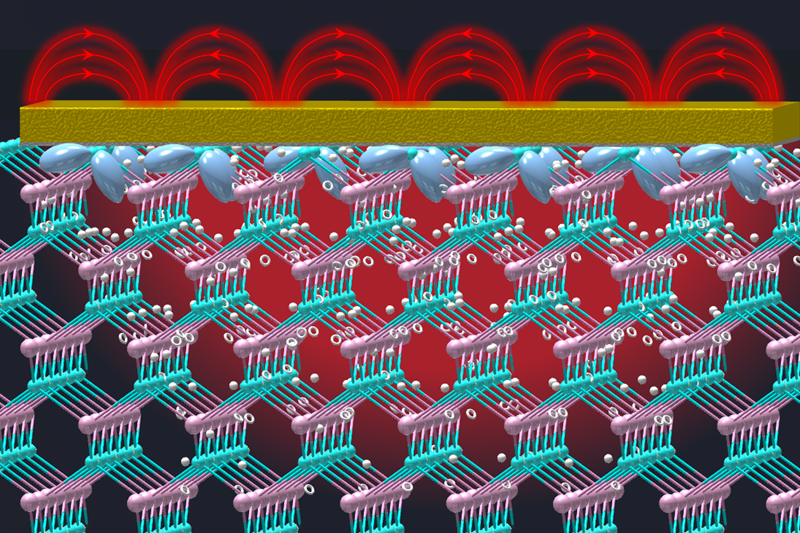Reviewed by Alex SmithAug 2 2021
At the Samueli School of Engineering from the University of California Los Angeles (UCLA), electrical engineers have come up with a highly efficient method of converting light from one wavelength to another.
 Schematic of InAs lattice in contact with a nanoantenna array that bends incoming light so it is tightly confined around the shallow surface of the semiconductor. Image Credit: Deniz Turan.
Schematic of InAs lattice in contact with a nanoantenna array that bends incoming light so it is tightly confined around the shallow surface of the semiconductor. Image Credit: Deniz Turan.
This paves the way for enhancements in the performance of sensing, imaging and communication systems. Mona Jarrahi, professor of electrical and computer engineering at UCLA Samueli, headed the study published in the journal Nature Communications.
Determining an efficient approach for the conversion of wavelengths into light tends to be critical to the enhancement of various imaging and sensing technologies. For instance, the conversion of incoming light into terahertz wavelengths allows the execution of imaging and sensing in optically opaque surroundings. Yet, earlier conversion frameworks were ineffective and, therefore, there was a need for heavy and complicated optical setups.
The UCLA-guided group has developed a solution to improve wavelength-conversion efficiency by examining an unwanted but natural phenomenon known as semiconductor surface states.
Surface states emerge when surface atoms tend to exhibit an inadequate number of other atoms to bind to, resulting in a breakdown in the atomic structure. Such unfinished chemical bonds are also called “dangling bonds” and lead to roadblocks for electric charges that flow via semiconductor devices, impacting their performance.
There have been many efforts to suppress the effect of surface states in semiconductor devices without realizing they have unique electrochemical properties that could enable unprecedented device functionalities.
Mona Jarrahi, Professor of Electrical and Computer Engineering, Samueli School of Engineering, University of California Los Angeles
Jarrahi also leads the UCLA Terahertz Electronics Laboratory. The scientists decided to leverage surface states for enhanced wavelength conversion as these incomplete bonds are vulnerable to make a shallow but huge built-in electric field throughout the surface of the semiconductor.
Incoming light has the potential to strike the electrons in the semiconductor lattice and shift them to a higher energy state, at a point where they are open to jumping around inside the lattice.
The electric field created throughout the semiconductor’s surface helps expedite the photo-excited and high-energy electrons further, which then discharge the surplus energy they acquired by radiating it at various optical wavelengths, thereby transforming the wavelengths.
However, this energy exchange can occur only at a semiconductor’s surface and must be highly efficient. To resolve this issue, the researchers integrated a nanoantenna array that bends incoming light so it is tightly confined near the shallow surface of the semiconductor.
Through this new framework, wavelength conversion happens easily and without any extra added source of energy as the incoming light crosses the field.
Deniz Turan, Study Lead Author, Samueli School of Engineering, University of California Los Angeles
Turan is also a member of Jarrahi’s Research Laboratory and recently graduated with his doctorate in electrical engineering from UCLA Samueli.
The scientists were successful in efficiently converting a 1,550-nm wavelength light beam into the terahertz part of the spectrum, varying from wavelengths of 100 μm up to 1 mm. The researchers illustrated the wavelength-conversion efficiency by integrating the new technology into an endoscopy probe that could be utilized for elaborate in-vivo imaging and spectroscopy by making use of terahertz waves.
In the absence of this discovery in wavelength conversion, it would have necessitated 100 times the optical power level to realize the same terahertz waves, which cannot be supported by the thin optical fibers utilized in the endoscopy probe. The breakthrough can be applied to optical wavelength conversion in other parts of the electromagnetic spectrum, varying from microwave to far-infrared wavelengths.
The co-authors of the study include two additional members from Jarrahi’s research group, Ping Keng Lu and Nezih Yardimci. The other co-authors are from Technical University Darmstadt in Germany and the Ames Laboratory, a U.S. Department of Energy (DOE) laboratory affiliated with Iowa State University.
This study was financially supported by the Office of Naval Research, and the DOE offered a grant for Turan.
Journal Reference:
Turan, D., et al. (2021) Wavelength conversion through plasmon-coupled surface states. Nature Communications. doi.org/10.1038/s41467-021-24957-1.